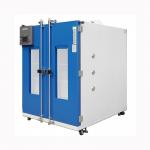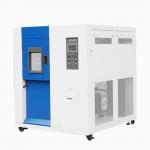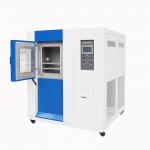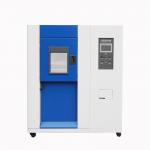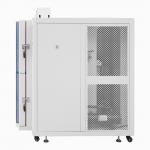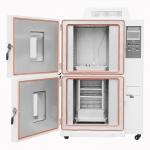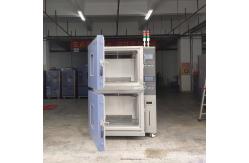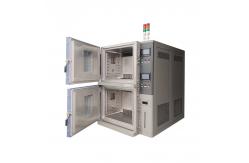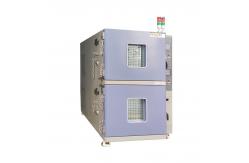In the modern industrial landscape, where environmental testing is
of paramount importance, the Energy-saving Thermal Shock Test
Chamber emerges as a game-changing solution. This innovative
equipment is designed to meet the rigorous demands of various
industries while minimizing energy consumption, thereby reducing
operational costs and environmental impact. The Energy-saving Thermal Shock Test Chamber is specifically
engineered to subject products to rapid and extreme temperature
changes, simulating the thermal stresses they might encounter in
real-world applications. It serves a wide range of industries,
including electronics, automotive, aerospace, and
telecommunications. The primary objective is to evaluate the
durability and reliability of products under thermal shock
conditions, enabling manufacturers to identify potential
weaknesses, optimize product designs, and ensure compliance with
industry standards. By incorporating energy-saving features, this
chamber not only provides accurate and reliable testing but also
contributes to sustainable manufacturing practices. - Efficient Insulation and Structural Design
- The chamber is constructed with high-quality insulation materials
that minimize heat transfer between the different temperature
zones. The double-wall structure, made of durable stainless steel
or other corrosion-resistant alloys, provides excellent thermal
insulation and structural integrity. The interior is designed to be
smooth and easy to clean, ensuring a contamination-free testing
environment. The door is equipped with a reliable sealing mechanism
and a viewing window, allowing operators to monitor the test
process without disturbing the internal conditions. The overall
design is optimized to reduce heat loss and energy consumption,
making it an environmentally friendly choice.
- Advanced Temperature Control System
- The heart of the chamber lies in its sophisticated temperature
control system. It can achieve a wide temperature range, typically
from -70°C to +150°C, with an accuracy of ±0.5°C. The system
utilizes a combination of high-performance refrigeration units,
powerful heaters, and a precise PID controller. What sets this
chamber apart is its ability to rapidly transition between
different temperature settings. It can achieve a temperature change
rate of up to 10°C per minute, ensuring that products are exposed
to the most severe thermal shock conditions. The control system
also features energy-saving modes, such as intelligent standby and
optimized compressor operation, which significantly reduce power
consumption during non-testing periods and idle times.
- Intuitive Control Panel and Data Acquisition Interface
- The equipment is equipped with an intuitive control panel that
simplifies the operation and parameter setting. Operators can
easily adjust the temperature profiles, test durations, and other
parameters using a user-friendly interface. The control panel also
provides real-time displays of the current temperature, the rate of
change, and any alarms or warnings. The chamber is integrated with
a comprehensive data acquisition system. It records all relevant
test data, such as temperature histories, thermal shock cycles, and
any observable changes in the test samples. The data can be stored
in a built-in memory or exported to external storage devices for
further analysis. The system can also generate detailed test
reports in various formats, facilitating easy documentation and
sharing of results.
- Versatile Sample Fixturing and Placement
- The interior of the chamber is designed to accommodate a variety of
sample sizes and shapes. It can be equipped with adjustable racks,
trays, and custom-made holders to ensure proper positioning and
exposure of the test samples. The sample fixturing is made of
materials that are resistant to extreme temperatures and do not
contaminate the test environment. This flexibility allows for the
testing of different products, from small electronic components and
connectors to larger automotive parts and aerospace assemblies.
- Safety Features and Alarms
- To ensure the safety of operators and the integrity of the testing
process, the chamber is equipped with a range of safety features.
These include over-temperature and over-current protection,
emergency stop buttons, and alarms for abnormal temperature
fluctuations or equipment malfunctions. The safety features are
designed to prevent damage to the chamber, the test samples, and
the surrounding environment, providing peace of mind during the
testing operation.
- Temperature Range and Accuracy
- With a temperature range of -70°C to +150°C and an accuracy of
±0.5°C, the chamber can subject products to a wide spectrum of
temperatures. This is crucial for testing products that may be
exposed to extreme cold, such as in cryogenic applications, or high
heat, like in industrial ovens. The accurate temperature control
ensures that the test conditions are precisely maintained,
providing reliable and repeatable results.
- Rapid Temperature Change Rate
- The chamber can achieve a rapid temperature change rate of up to
10°C per minute. This allows for the simulation of real-world
scenarios where products may experience sudden temperature shifts,
such as in automotive engines during startup or in electronics
during thermal shock testing. The ability to quickly change the
temperature helps in identifying potential weaknesses in products
that may not be apparent under static temperature conditions.
- Testing Volume and Payload Capacity
- The chamber offers a customizable testing volume, typically ranging
from 50L to 500L, depending on the specific model. The payload
capacity can handle a significant amount of test samples, with a
maximum capacity of up to 200 kg, depending on the size and density
of the objects. This allows for efficient testing of a batch of
products or a single, relatively large item.
- Data Sampling Frequency and Resolution
- The data acquisition system samples data at a frequency of up to
150 Hz, providing a detailed record of the temperature changes. The
resolution of the temperature data is 0.1°C. This high-resolution
data is invaluable for identifying even the slightest trends and
potential failure points, allowing for a more accurate assessment
of product performance.
- Accurate Simulation of Thermal Shock Conditions
- The primary function of the chamber is to provide a precise and
reliable simulation of rapid temperature change conditions. By
subjecting products to controlled and extreme thermal shocks, it
allows manufacturers and researchers to evaluate their performance
and durability. This is crucial for ensuring the quality and
reliability of products such as electronics, which may malfunction
during thermal shock, or automotive components, which need to
withstand temperature fluctuations during operation.
|
